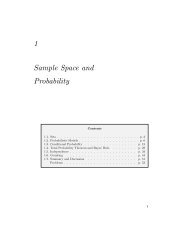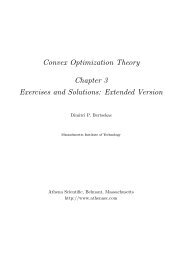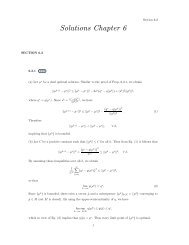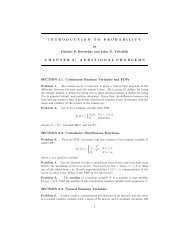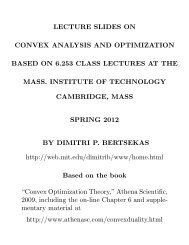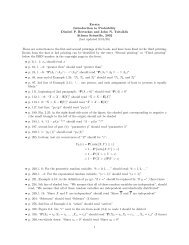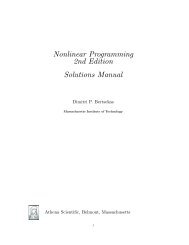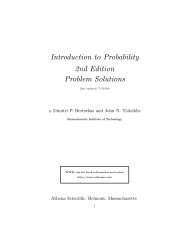Introduction to Probability, by Dimitri P ... - satrajit mukherjee
Introduction to Probability, by Dimitri P ... - satrajit mukherjee
Introduction to Probability, by Dimitri P ... - satrajit mukherjee
You also want an ePaper? Increase the reach of your titles
YUMPU automatically turns print PDFs into web optimized ePapers that Google loves.
Sec. 1.5 Independence 37<br />
Example 1.21. There are two coins, a blue and a red one. We choose one of<br />
the two at random, each being chosen with probability 1/2, and proceed with two<br />
independent <strong>to</strong>sses. The coins are biased: with the blue coin, the probability of<br />
heads in any given <strong>to</strong>ss is 0.99, whereas for the red coin it is 0.01.<br />
Let B be the event that the blue coin was selected. Let also H i be the event<br />
that the ith <strong>to</strong>ss resulted in heads. Given the choice of a coin, the events H 1 and<br />
H 2 are independent, because of our assumption of independent <strong>to</strong>sses. Thus,<br />
P(H 1 ∩ H 2 | B) =P(H 1 | B)P(H 2 | B) =0.99 · 0.99.<br />
On the other hand, the events H 1 and H 2 are not independent. Intuitively, if we<br />
are <strong>to</strong>ld that the first <strong>to</strong>ss resulted in heads, this leads us <strong>to</strong> suspect that the blue<br />
coin was selected, in which case, we expect the second <strong>to</strong>ss <strong>to</strong> also result in heads.<br />
Mathematically, we use the <strong>to</strong>tal probability theorem <strong>to</strong> obtain<br />
P(H 1)=P(B)P(H 1 | B)+P(B c )P(H 1 | B c )= 1 2 · 0.99 + 1 2 · 0.01 = 1 2 ,<br />
as should be expected from symmetry considerations. Similarly, we have P(H 2)=<br />
1/2. Now notice that<br />
P(H 1 ∩ H 2)=P(B)P(H 1 ∩ H 2 | B)+P(B c )P(H 1 ∩ H 2 | B c )<br />
= 1 2 · 0.99 · 0.99 + 1 2 · 0.01 · 0.01 ≈ 1 2 .<br />
Thus, P(H 1 ∩ H 2) ≠ P(H 1)P(H 2), and the events H 1 and H 2 are dependent, even<br />
though they are conditionally independent given B.<br />
As mentioned earlier, if A and B are independent, the occurrence of B does<br />
not provide any new information on the probability of A occurring. It is then<br />
intuitive that the non-occurrence of B should also provide no information on the<br />
probability of A. Indeed, it can be verified that if A and B are independent, the<br />
same holds true for A and B c (see the end-of-chapter problems).<br />
We now summarize.<br />
Independence<br />
• Two events A and B are said <strong>to</strong> be independent if<br />
P(A ∩ B) =P(A)P(B).<br />
If in addition, P(B) > 0, independence is equivalent <strong>to</strong> the condition<br />
P(A | B) =P(A).



